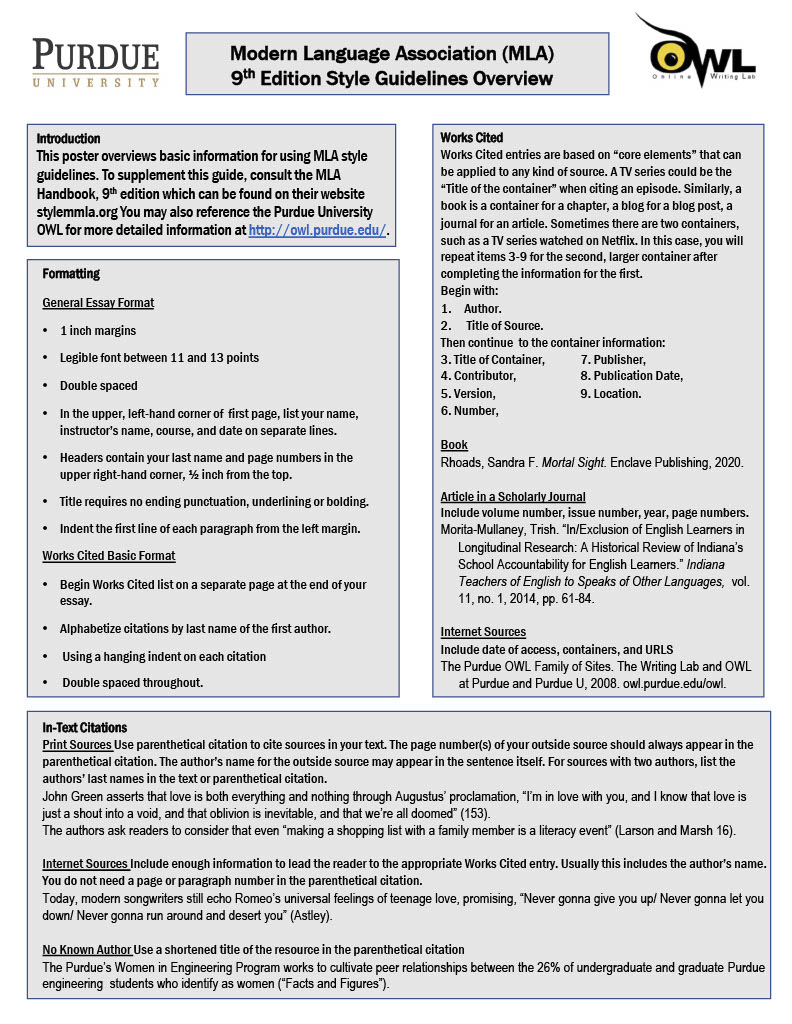
https://owl.purdue.edu/owl/research_and_citation/mla_style/mla_formatting_and_style_guide/20211015MLA9Poster.jpg


When deciding how to cite your source, start by consulting the list of core elements. These are the general pieces of information that MLA suggests including in each Works Cited entry. In your citation, the elements should be listed in the following order:
Book Example:
Henley, Patricia. The Hummingbird House. MacMurray, 1999.
Webpage Example:
Lundman, Susan. "How to Make Vegetarian Chili." eHow,
www.ehow.com/how_10727_make-vegetarian-chili.html.
Journal Example:
Bagchi, Alaknanda. "Conflicting Nationalisms: The Voice of the Subaltern in Mahasweta Devi's Bashai Tudu."
Tulsa Studies in Women's Literature, vol. 15, no. 1, 1996, pp. 41-50.
Documenting sources for images can be challenging, especially with the variety of new electronic resources now available. Many different style manuals exist. Always ask your class instructor for the style appropriate for the course.
Artist’s last name, first name. Title of art work in italics. Date of art work.
Institution where artwork is housed (if known), city where housed if
not already named. Title of printed source in italics. By Author of printed
source. Place of publication: publisher, date. Page or plate/figure/slide
number. Print.
example:
Cassatt, Mary. Mother and Child . Wichita Art Museum. c.1890. American
Painting: 1560-1913 . By John Pearce. New York: McGraw, 1964.
Slide 22. Print.
Artist’s last name, first name. Title of art work in italics. Date of art work.
Institution where art work is housed (if known), city where housed if not
already named. Database or web site name. Web. Day month year
accessed.
example:
Monet, Claude. Meadow with Haystacks at Giverny. 1885. Museum of Fine
Arts, Boston. ARTstor. Web. 22 October 2004.
Some annotations are merely descriptive, summarizing the authors' qualifications, research methods, and arguments. Your professor might also ask you to identify the authors' theoretical frameworks.
Many annotations evaluate the quality of scholarship in a book or article. You might want to consider the logic of authors' arguments, and the quality of their evidence. Your findings can be positive, negative, or mixed.
Your professor might also want you to explain why the source is relevant to your assignment.
Generally, annotations should be no more than 150 words (or 4-6 sentences long). They should be concise and well-written. Depending on your assignment, annotations may include some or all of the following information:
An Informative/descriptive annotation describes the content of the work without judging it. It does point out distinctive features.
|
London, Herbert. "Five Myths of the Television Age." Television Quarterly Herbert London, the Dean of Journalism at New York University and author of several books and articles, explains how television contradicts five commonly believed ideas. He uses specific examples of events seen on television, such as the assassination of John Kennedy, to illustrate his points. His examples have been selected to contradict such truisms as: "seeing is believing"; "a picture is worth a thousand words"; and "satisfaction is its own reward." London uses logical arguments to support his ideas which are his personal opinion. He doesn't refer to any previous works on the topic. London's style and vocabulary would make the article of interest to any reader. |